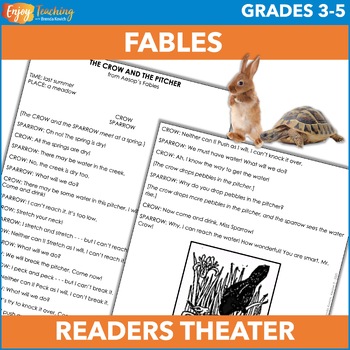Aesop's Fables Readers Theater Scripts or Plays for 3rd, 4th & 5th Grades
- PDF
- Easel Activity
What educators are saying
Also included in
- This fables unit offers a complete reading, writing, speaking, and listening experience! It includes lesson plans, 10 stories with comprehension questions, 7 plays, writing, and compare-contrast activities. You’ll have everything you need to teach your third, fourth, or fifth grade students. Open thPrice $21.20Original Price $26.50Save $5.30
- Give your students a complete drama experience! After learning about structural elements, they annotate and act out plays. Then they rewrite two-page stories in dramatic form. As a bonus, the bundle also includes an assessment.Open the previews to take a closer look at the activities.1. Present elemPrice $14.00Original Price $17.00Save $3.00
Description
Seven plays present Aesop’s fables in dramatic form. Scripts may be used for short skits, readers theater, or full-blown plays – for up to 40 students! Additionally, kids learn and label elements of drama.
Open the preview to take a closer look at the activities.
First, kids learn about structural elements of drama. Two reference guides offer definitions, as well as an annotated example.
- Cast of characters – list of characters in a play
- Dialogue – words that tell the actors what to say
- Character tag – name that tells which actor should speak
- Stage directions – description of how the stage should look or what the actors should do
- Setting – text that tell where and when a play takes place
- Scenes – sections of the play with similar setting
- Acts – major sections of a long play
Second, you can provide the first page of one script as an exit ticket. Kids label elements of drama on the text.
Then they’re ready to act out some plays. These fables, written in dramatic form, provide readers theater scripts for more than 40 students.
- “The Boy Who Cried Wolf” – seven characters
- “The Crow and the Fox” – three characters
- “The Crow and the Pitcher” – two characters
- “The Miller, His Son, and Their Donkey” – fourteen characters
- “The Pot of Gold” – five characters
- “The Wolf and the Goat” – three characters
- “The Wolf and the Horse” – seven or more characters
Files include everything you need for third, fourth, and fifth grade students to analyze and act out plays:
- Lesson plans
- Structures of drama student reference guides
- 7 reproducible plays
Scripts can be used flexibly:
- As skits, readers theater, or full-blown plays
- For practice in labeling elements of drama
- With small group or whole class
Materials are available in printable and digital forms.
- A PDF provides a traditional format.
- Easel Activities let kids work online.
Looking for more? Check out my Aesop’s fables unit.
Enjoy teaching!
Brenda Kovich
All plays, based on Aesop’s Fables, have been adapted from Children’s Classics in Dramatic Form, Books 1 and 2, by Augusta Stevenson Published in 1908 and 1909, the texts are now in the public domain.







